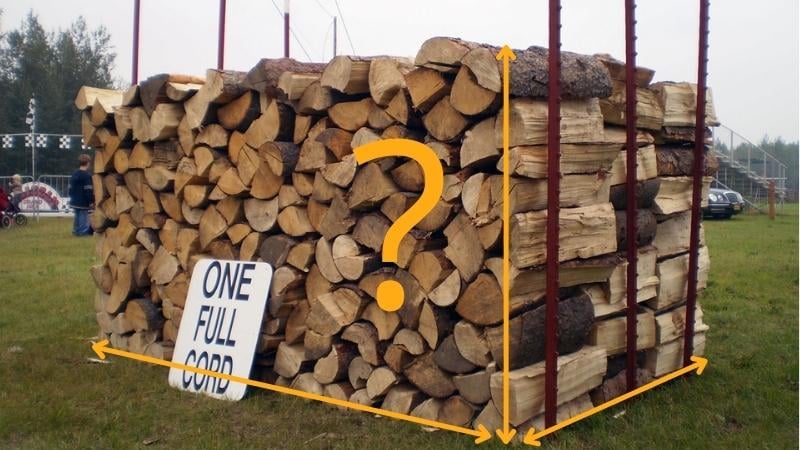The word cord has a lot of different meanings, and the one that has to do with wood isn’t the most well-known.
However, in the United States, Canada, and other countries, a cord is a unit of measurement used to measure firewood and pulpwood; and because many people buy wood for a variety of reasons, including lighting their fireplaces and building small wooden houses.
It’s important to understand the dimensions of a cord of wood, among other things, to ensure that you always get the best value.
A cord is a 4-foot-wide, 4-foot-tall, and 8-foot-long neatly arranged stack of wood. It should be 128 cubic feet in total volume (3.5 cubic meters). Although the amount of solid wood in a cord varies depending on the size of each piece, most cords of firewood include 85 cubic feet (2.4 cubic meters) of solid wood on average. Air takes up the remainder of the volume.
The pile’s total length should be 8 feet (2.4 meters), but each piece of wood should be around 4 feet long and match the width or depth of the pile (1.2 m).
The amount of usable wood in a cord depends on a variety of criteria, including the type of wood, the size and straightness of the pieces, and the amount of bark present. About one cord of wood can be found in a tree with a usable height of 40 feet and a circumference of 6.25 feet.
However, in addition to the well-known cord, there are other types of metrics regularly used in measuring the wood, and these metrics are frequently used in selling to home users in place of cords. They will be briefly described in connection to their dimensions in the following paragraphs.
Face Cord
The next most common unit of measurement is the face cord. It refers to any 4 foot (1.2 m) high and 8 foot (2.4 m) long stack of wood. The pile’s depth or width is less than 4 feet (1.2 m), implying that each piece of wood in the pile is less than 4 feet (1.2 m).
In a face cord, there is no standard length for the pieces of wood. Most firewood is 16 inches (40.6 cm) long on average, hence most face piles are 16 inches deep (40.6 cm). This is one-third of a whole cord’s depth.
The term “rick” and “fireplace cord” are used interchangeably for face cords, however, there are some regional distinctions. You must keep in mind that all of these volume calculations are approximate. Individual log characteristics, stacking technique, and whether or not the wood has been split all play a role in determining how much wood is actually purchased, regardless of whether it is sold by the cord, face cord, or rick.
Thrown Cord
Wood that has been flung or dumped into a truck rather than packed into tidy, compact piles is referred to as thrown cord or loosely thrown cord.
In its natural state, a thrown cord should occupy around 180 cubic feet (6.66 cubic meters) of space. To put it another way, when stacked together, the volume would be roughly the same as a full cord of wood but a “thrown” cord uses around 30% more space than a “stacked” cord.
For a typical pickup truck with a 6ft. bed, the volume is 54 cubic feet, while for an 8ft. bed, the volume is 81 cubic feet (3 cubic yards – heaped load- Stacked). If you’d like to save some space, consider stacking instead of throwing, because the “thrown” cord content of a 6ft. truckload is 30% +-; on the other hand, an 8ft. truckload is 45% +- when compared to a stacked cord.
Green Cord
Measurements collected before the timber was split and dried are referred to as “green cord.”
As a result, the actual or dry volume may be 8 cubic feet lower than the quoted volume (0.23 cubic meters). As with a standard full cord, the capacity of the green cord should be 128 cubic feet (3.5 meters) if placed neatly, or 180 cubic feet (5.1 meters) if packed loosely.
Wood that hasn’t been seasoned shrinks by 6 to 8 percent when it is dry. As a strategy to compensate for the loss that would be incurred as a result of the shrinking of wood, firewood traders may measure and price their products by the green cord instead of whole cords or loose cords.
Buying Unstandardized Wood

Wood may be sold in truckloads, piles, station wagon loads, or pick-up truck loads by a dealer.
This type of measurement is not standardized, making it difficult to compare results. As a result, you may end up with far less wood than you paid for. Because of this, it is imperative that you take your own measures; Taking measurements from the stacks of wood you intend to purchase is the safest way to ensure that you get the expected value for what you’re paying for.
In addition, one should be aware of the wood’s density. The energy content per gram of weight is the same for all wood species. To this end, volume purchases of wood pose a problem. As a result, a cord of yellow poplar will provide far less warmth than a cord of red oak. However, on the bright side, woods with lesser density are more likely to start a fire sooner.
Conclusion
The wood in your house may also be attractive to species that dwell in the forest, making it an ideal spot for them to feed and breed. As a result, it is advised that wood be seasoned for at least a year in an elevated but dry position outside. A tarp and old pallets are a fantastic combination for protecting firewood from the rain.
Nothing beats sitting around a fire in the cold winter months, and with the above tips, you are sure to get the value for your buck the next time you buy wood.
The dimension of stuff has been an interest of mine ever since I was a child. What I believe is most fascinating about the dimension of stuff is how extremely long, tall and wide some objects are both on earth and in the universe.

